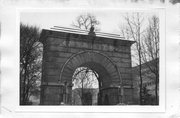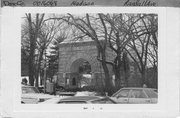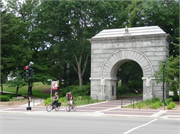| Additional Information: | A 'site file' exists for this property. It contains additional information such as correspondence, newspaper clippings, or historical information. It is a public record and may be viewed in person at the Wisconsin Historical Society, State Historic Preservation Office.
Lew F. Porter designed the arch which was dedicated in June of 1912. Prior to the outbreak of the Civil War, this area served as the state's fairground. In 1861 it was converted to barracks and hospitals which accommodated 8,000 men. S in the photo codes is short for SOS! negatives.
City of Madison, Wisconsin Underrepresented Communities Historic Resource Survey Report:
George Coleman Poage was born in 1880 in Hannibal, Missouri. His parents were both born in slavery in Missouri and moved to La Crosse, Wisconsin in search of better employment in 1884. Poage’s father worked as a popular coachman for the family of the local industrialist Albert Pettibone and later the wealthy La Crosse family of John Easton. After his father died in 1889, his mother continued to work for the city’s elite. George was an accomplished student and salutatorian of his graduating class at La Crosse High School. He was also a star athlete in track and field and was considered one of the best sprinters in the state.
Due to his academic and athletic achievements, he enrolled at the University of Wisconsin-Madison in 1899 with some financial help from the Easton family. While a student at the university, George Poage lived with Benjamin and Amy Butts and their three children at the extant side-gabled house located at 633 East Johnson Street. The house was constructed earlier in the early 1870s. In 1901, Poage moved from the Butts household to a non-extant house at 1109 W. Johnson Street, where he lived with several other students.
Poage was a very successful sprinter for the University of Wisconsin-Madison, setting many records during the period. He routinely had times of approximately 10 seconds for the 100-yard dash, 21.5 seconds for the 220-yard dash, and 49.5 seconds for the 440-yard dash, all impressive times at the turn-of-the-century. He became one of, if not the most, recognized African Americans in Madison and the state. The site of the track and playing fields for the university at the turn of the twentieth century, now non-extant, was a large open space and a series of bleachers arranged along the northern end of the site of present-day Camp Randall Stadium. The site of the former Union army Civil War camp, Camp Randall, was purchased by the university for use as athletic playing fields in 1893; the football stadium was completed on the site in 1916, which has been expanded and remodeled extensively over the past seven decades, and a field house was constructed there in 1929.
His attendance at the University of Wisconsin paralleled the rise and popularity of college athletics in the United States. Poage was a recognized star athlete on campus while internal debate went on regarding the emphasis and value of college sports. After his graduation in 1903, there was a small scandal regarding the university’s attempt to extend his eligibility to participate and compete in track events for another academic year. Poage became an employee of the Athletic Department and re-enrolled in classes despite already graduating. Other athletes at the university and elsewhere experienced a similar arrangement and sparked a debate over the role of college athletics as an amateur student club or a semi-professional profitable division of college institutions, a debate continues to the present.
In 1903, he joined the exclusive, all-White Milwaukee Athletic Club who sponsored him in the revived Olympic Games held in St. Louis in 1904. Poage was the first African American to compete in the Olympics. He competed in four events: the 400-meter dash, the 60-meter dash, the 400-meter high hurdles, in which he finished third and was awarded a bronze medal, and the 200-meter low-hurdle, in which he also finished third and was awarded a bronze medal. After he competed in the Olympic Games, Poage remained in St. Louis and later Chicago. George Poage died in 1962. |
|---|




